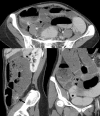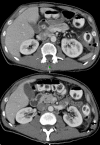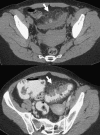CT findings of misleading features of colonic diverticulitis
- PMID: 22347935
- PMCID: PMC3259374
- DOI: 10.1007/s13244-010-0051-6
CT findings of misleading features of colonic diverticulitis
Abstract
Colonic diverticulitis (CD) is a common entity whose diagnosis is particularly based on computed tomography (CT) examination, which is the imaging technique of choice. However, unusual CT findings of CD may lead to several difficulties and potential pitfalls: due to technical errors in the management of the CT examination, due to the anatomical situation of the diseased colon, in diagnosing unusual complications that may concern the gastrointestinal tract, intra- and retroperitoneal viscera or the abdominal wall, and in differentiating CD from other abdominal inflammatory and infectious conditions or colonic cancer. The aim of this work is to delineate the pitfalls of CT imaging and illustrate misleading CT features in patients with suspected CD.
Figures



























Similar articles
-
Computed tomography in the imaging of colonic diverticulitis.Clin Radiol. 2004 Nov;59(11):977-83. doi: 10.1016/j.crad.2004.05.003. Clin Radiol. 2004. PMID: 15488845 Review.
-
Appendicitis and diverticulitis of the colon: misleading forms.Diagn Interv Imaging. 2013 Jul-Aug;94(7-8):771-92. doi: 10.1016/j.diii.2013.03.009. Epub 2013 Jun 10. Diagn Interv Imaging. 2013. PMID: 23759294
-
[The role of spiral computed tomography in sigmoid diverticulitis and the diagnostic-therapeutic implications].Radiol Med. 2000 Mar;99(3):165-8. Radiol Med. 2000. PMID: 10879164 Italian.
-
Helical CT with only colonic contrast material for diagnosing diverticulitis: prospective evaluation of 150 patients.AJR Am J Roentgenol. 1998 Jun;170(6):1445-9. doi: 10.2214/ajr.170.6.9609151. AJR Am J Roentgenol. 1998. PMID: 9609151
-
Ultrasound of colon diverticulitis.Dig Dis. 2012;30(1):56-9. doi: 10.1159/000336620. Epub 2012 May 3. Dig Dis. 2012. PMID: 22572686 Review.
Cited by
-
Update on the management of sigmoid diverticulitis.World J Gastroenterol. 2021 Mar 7;27(9):760-781. doi: 10.3748/wjg.v27.i9.760. World J Gastroenterol. 2021. PMID: 33727769 Free PMC article. Review.
-
Gastrointestinal perforation: clinical and MDCT clues for identification of aetiology.Insights Imaging. 2020 Feb 21;11(1):31. doi: 10.1186/s13244-019-0823-6. Insights Imaging. 2020. PMID: 32086627 Free PMC article.
-
Management of Diverticular Disease in the Setting of Other Colorectal Pathology: Data on Simultaneous Issues in Segmental Colitis, Inflammatory Bowel Disease, Cancer, and Complications.Clin Colon Rectal Surg. 2018 Jul;31(4):226-228. doi: 10.1055/s-0037-1607468. Epub 2018 Jun 22. Clin Colon Rectal Surg. 2018. PMID: 29942212 Free PMC article. Review.
-
Short Occult Retractile Fibrous Scar Causing Exclusive Retrograde Stenosis of the Sigmoid Colon: An Incidental Diagnosis Nineteen Years After a Single Episode of Colonic Diverticulitis.J Belg Soc Radiol. 2016 Feb 15;100(1):31. doi: 10.5334/jbr-btr.933. J Belg Soc Radiol. 2016. PMID: 30151448 Free PMC article.
-
Is colonoscopy necessary after computed tomography diagnosis of acute diverticulitis?Intest Res. 2014 Jul;12(3):221-8. doi: 10.5217/ir.2014.12.3.221. Epub 2014 Jul 25. Intest Res. 2014. PMID: 25349596 Free PMC article.
References
-
- Zins M, Bruel JM, Pochet P, Regent D, Loiseau D. Question 1. What is the diagnostic value of the different tests for simple and complicated diverticulitis? What diagnostic strategy should be used? Gastroentérol Clin Biol. 2007;31:3S15–3S19. - PubMed
-
- Balthazar EJ, Megibow A, Schinella RA, Gordon R. Limitations in the CT diagnosis of acute diverticulitis: comparison of CT, contrast enema, and pathologic findings in 16 patients. AJR Am J Roentgenol. 1990;154:281–285. - PubMed
LinkOut - more resources
Full Text Sources
